| Report Type | Full |
| Peak(s) |
Cathedral Peak - 13,952 feet |
| Date Posted | 12/18/2023 |
| Date Climbed | 09/27/2023 |
| Author | PikaSteve |
| Autumn Awe at the Cathedral |
|---|
|
Autumn Awe at the Cathedral Leaving the truck by headlamp at 6:00am, I was prepared for a long day. I knew that the standard gully to Cathedral Peak’s south ridge is usually climbed in late spring or early summer and rarely attempted in late summer or early autumn, but I felt ready for the challenge. I had carefully studied many trip reports, weighed the pros and cons of snowy vs dirty ascents, practiced my dirt climbing and chosen a day with a perfect weather forecast. 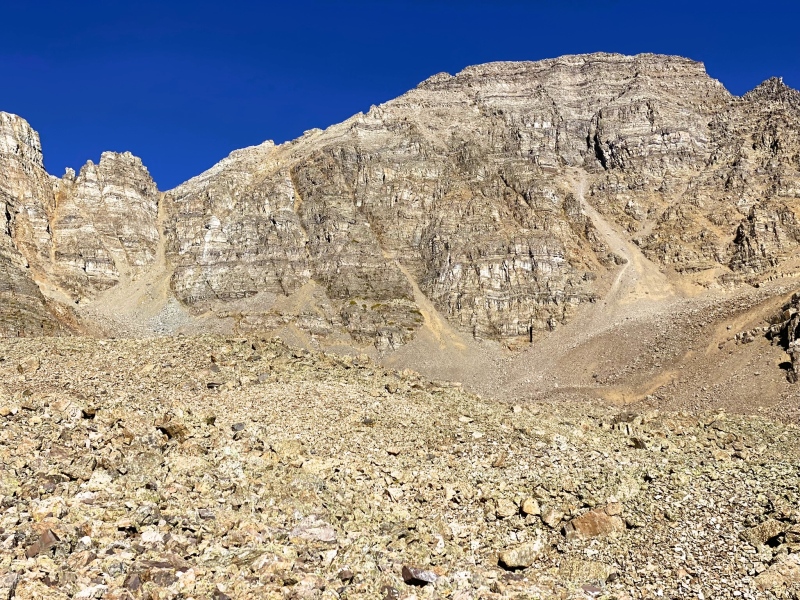
I wasn’t prepared for the awe that I would experience during a strenuous day surrounded by natural beauty: the wonder of seeing the golden leaves, blue skies, maroon cliffs, turquoise lake and a few dustings of white snow, not to mention talus and dirt in all shades of brown; the adrenaline-inspiring fear while climbing five hundred feet of steep dirt; the surprise of still feeling strong as I stood on the summit; the amazement of looking out at the Elk Mountain 14ers and aspen filled valleys. All feelings combined into that unique sensation best described as a rocky mountain high. The sensations sustained me throughout the long ascent and almost as long descent back to the trailhead at 8:30pm. The sense of awe returns every time I remember that joyful autumn day at the Cathedral. 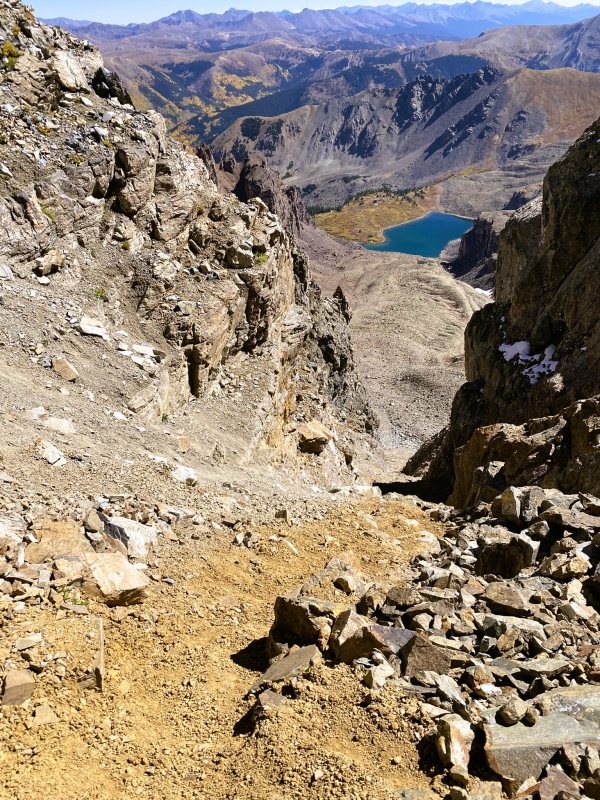
I thought I was done with lists when I finished climbing Colorado’s 14ers in 2021. But I had already done some Centennials during early season conditioning hikes within day-trip distance of Denver. And I didn’t want to stop hiking in the high mountains. And now I was looking at a line of green check marks with some blank spaces that seemed to be asking to be filled. Somehow, I found myself drawn into the Centennials list, or at least the 13.9ers list. I started researching the more difficult 13,900’+ summits and saw that Cathedral Peak would be a big challenge, particularly since I rarely climb on snow. I wondered if I could safely climb up the snow or if maybe climbing up dirt would be feasible and less miserable than the few 14ers.com reports suggested. In late September, a few factors aligned to inspire me to try an autumn climb of Cathedral Peak. First, the weather had been warm and sunny for many days after early September snows. Second, in June, my wife and I had already made plans for a late September leaf-viewing trip to Aspen. Third, another list-checking itch challenged me to climb at least one Elk Range peak this year. Fourth, one week earlier, I had hiked up Casco Peak: the crawling up loose dirt to reach Casco’s Fiascol saddle wasn’t too miserable; according to my Caltopo measurements, Casco’s 250’ dirt slope was about the same steepness as Cathedral’s 500’ gully; and the view of Cathedral Peak seemed to be calling me. 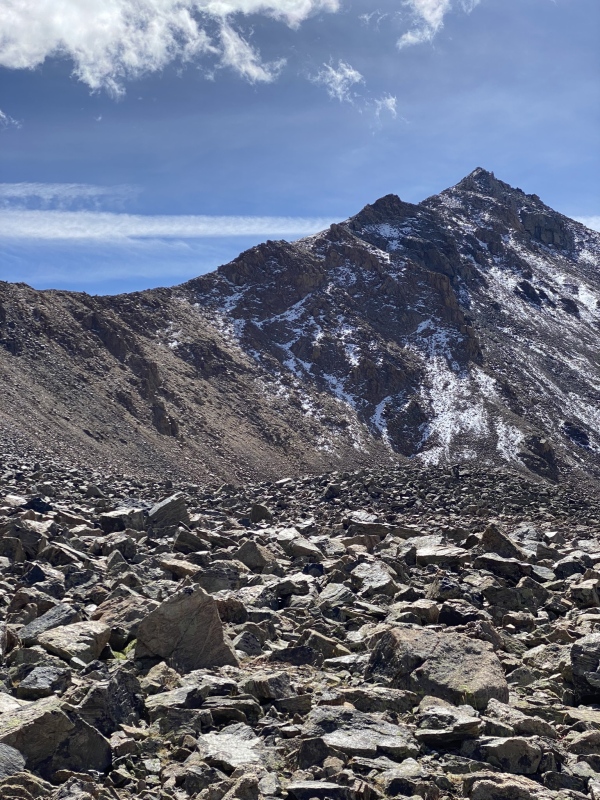
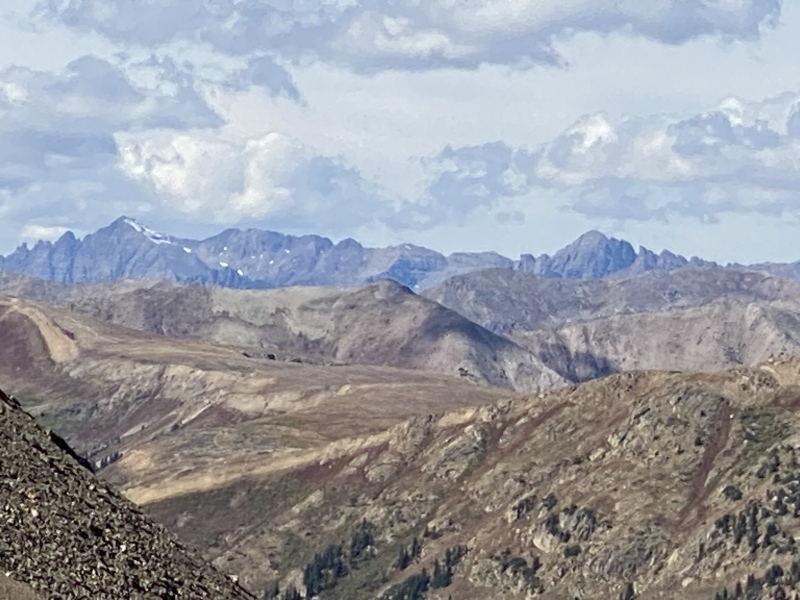
Wednesday, September 27, 2023 After leaving a “budget” condo-hotel in Aspen at 5:15, I started under the stars from Cathedral Lake Trailhead at 6:00am. Starting about an hour before sunrise meant that I couldn’t see colors in the thick aspen groves near the trailhead, but I still enjoyed seeing the tree trunk shadows and feeling the crunch of lightly frosted leaves covering the steep, well maintained trail. As the trail passed the wilderness boundary and turned to parallel Pine Creek, there was enough light to see the fluttering golden aspen leaves and red undergrowth. Looking backward revealed the green and gold covered slopes above Ashcroft. Looking ahead, Malamute Peak came into view, painted orange by the morning light. The stunning colors set the tone for feeling spiritual on the way to the Cathedral. 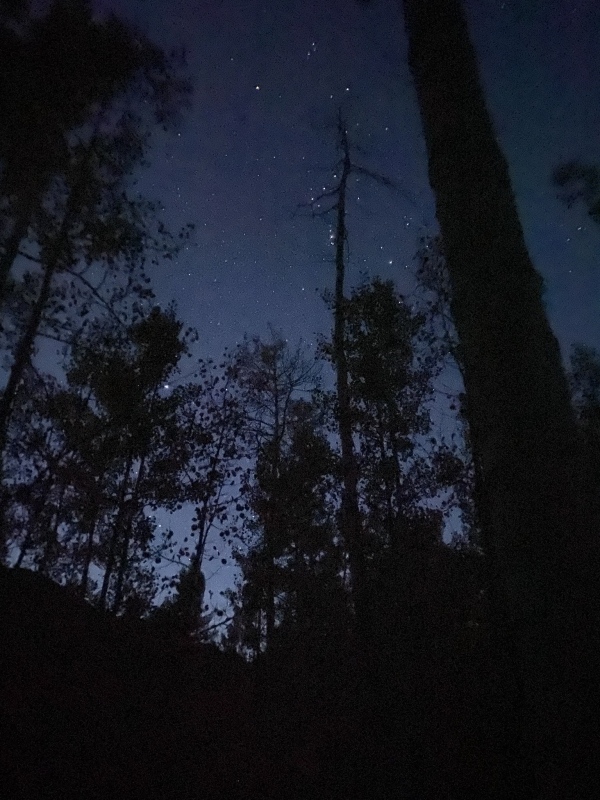


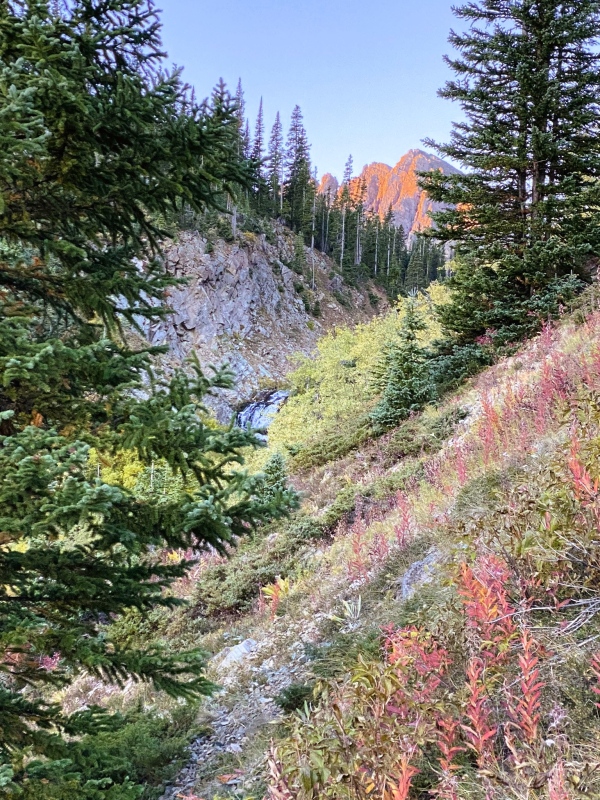
After huffing up a set of switchbacks and veering right at the Cathedral Lake junction to stay on the Electric Pass trail, Cathedral Peak’s east ridge spires came into view. I stayed on the trail until just below 12,000’. Where the trail turns right to head north, I turned left into the willows. By going so high on the trail, I had only a short walk through relatively thin willows but then I had to lose elevation to connect with the “miner’s trail”. From above, the trail was easily visible where it crossed a patch of grass on the other side of the ravine. 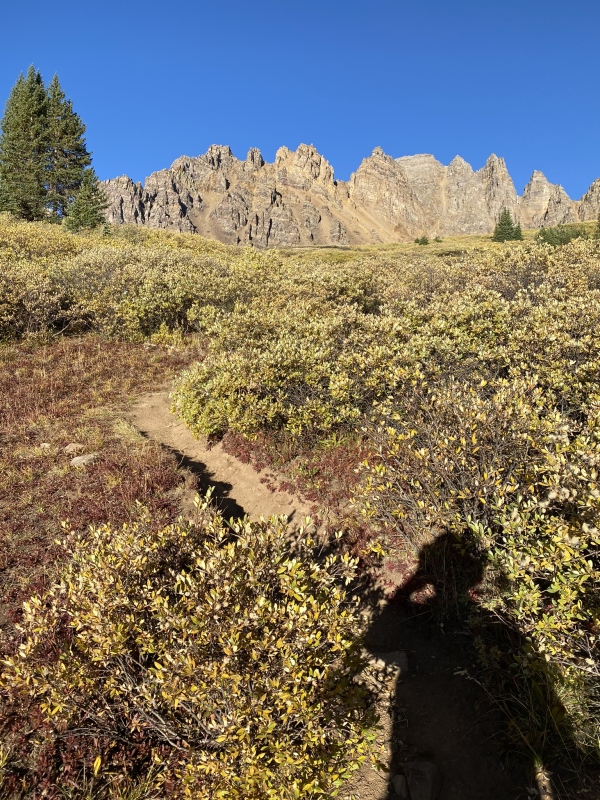

Leaving the willows, I traded spectacular views of fall foliage for wonderful views of blue lakes, banded cliffs, jumbled maroon boulders and layered mountainsides cut by narrow couloirs. The miner’s trail was easy to follow as it headed into the basin above Cathedral Lake. The trail first goes below the cliffs at the end of Cathedral’s east ridge before crossing the toe of the basin’s rock glacier and paralleling cliffs on the south side of the basin. By the time the trail reached the miner’s cabin’s last remnants at about 12,600’, the gully to access the south ridge dominated the views and my thoughts. Talus hopping took me to 12,800’ and the base of the gully where I took a long break to refuel and reconsider climbing higher. While snacking, I decided I was enjoying the unexpected beauty too much to turn around without seeing the view from the top. 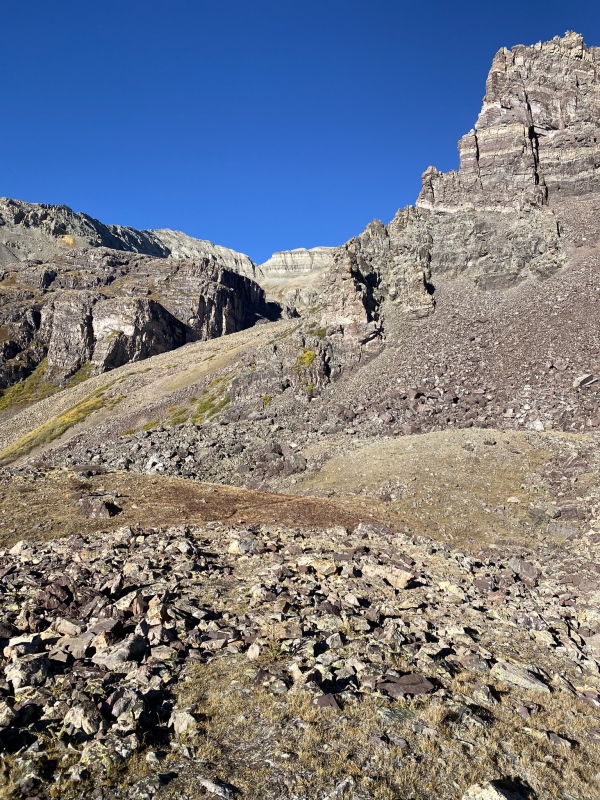

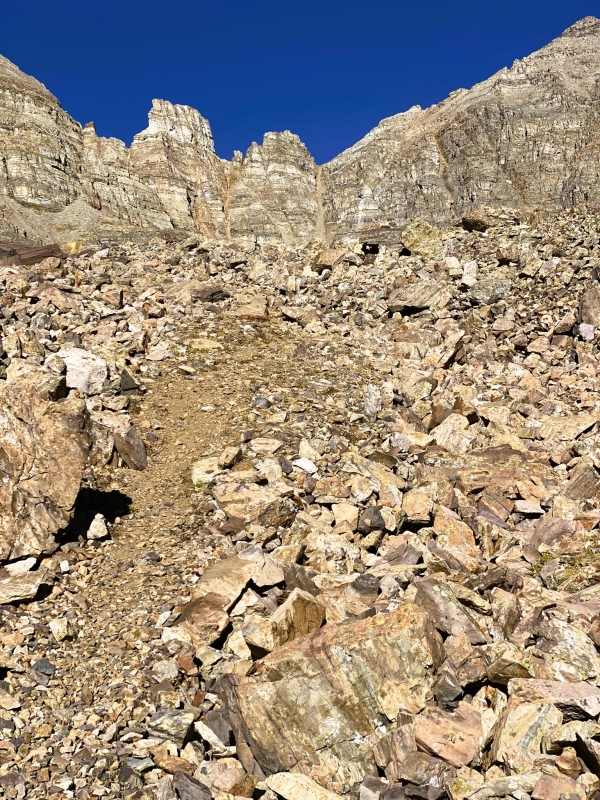

With my calories and my nerve replenished, I moved up the fan of debris that spills out from the gully. I paused briefly above 13,000’ to put on microspikes, stow one pole and admire the rock glacier leading towards Cathedral Lake. Moving slowly and ungracefully upward, my route alternated between crumbling rock, loose dirt and rocks resting on dirt. In a few places, class 3 moves took me up stable rock on the edges. In other sections, steep walls forced me into the dirt where I alternated between pole assisted side stepping and bear crawling on all fours. In a few places, I wedged my body against the left wall while a sharp pole and a spiked sole took turns gripping the dirt. The center of the gully often held an unstable stack of loose rocks which added spiciness whenever I switched from one edge to the other in search of a less difficult path. Thanks to the microspikes and pole, I never felt like I was going to lose traction, but anxiety activated my fight or flight response and triggered a flow of adrenaline. 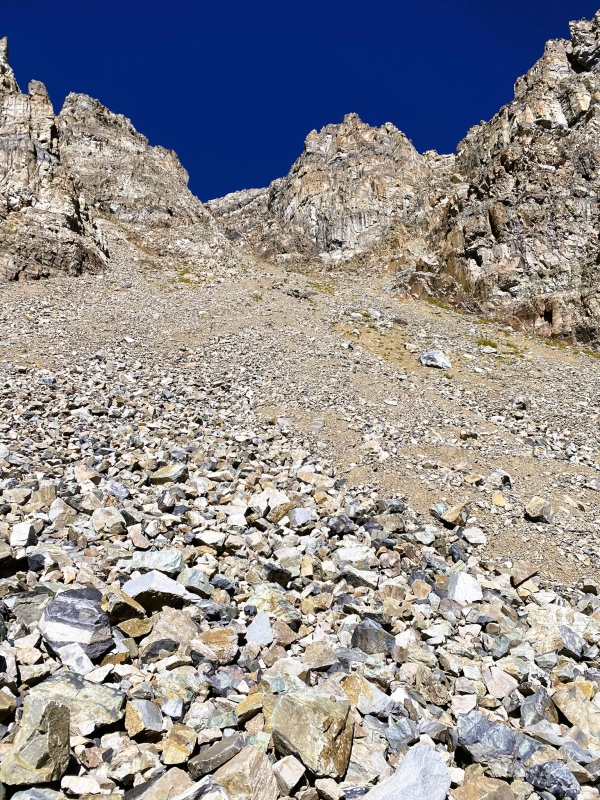

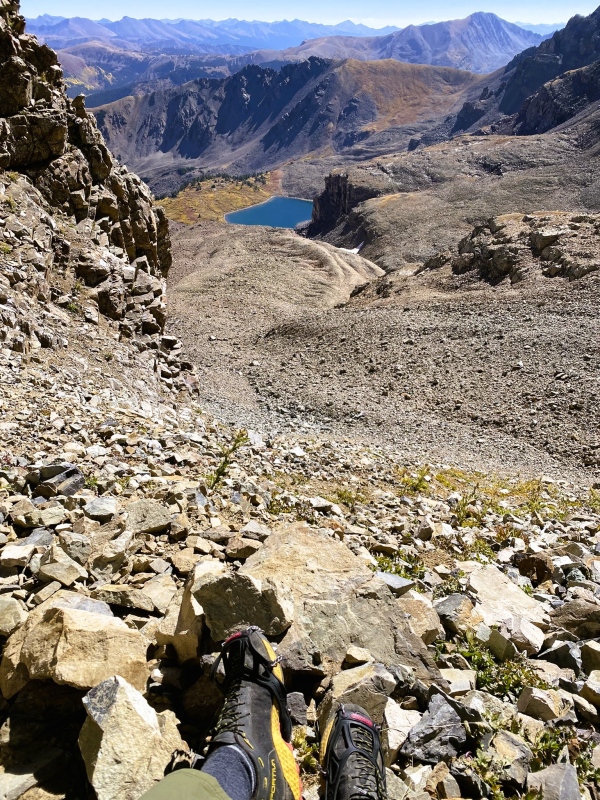
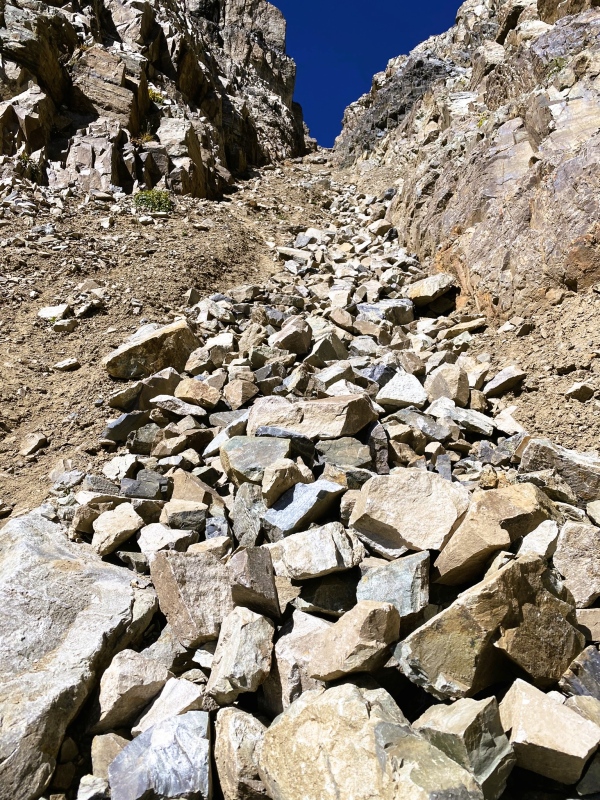
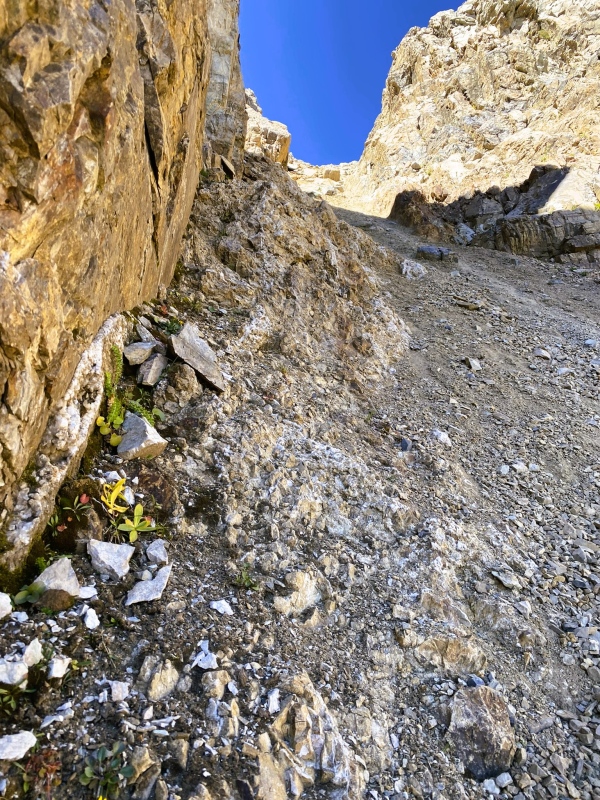
The slope got even steeper, the walls narrowed further and my heart beat faster during the final crawl to the col. As I reached the ridgeline, exhaustion and anxiety were replaced by elation and relief. The new feelings were suddenly eclipsed by amazement as I looked up to see the full Elk Range palette to the west: gold, green and rust on the opposite side of Conundrum creek; maroon layers of the Pyramid and Bells ridges; vivid reds on Sievers Mountain; and bright white Capital Peak in the distance. 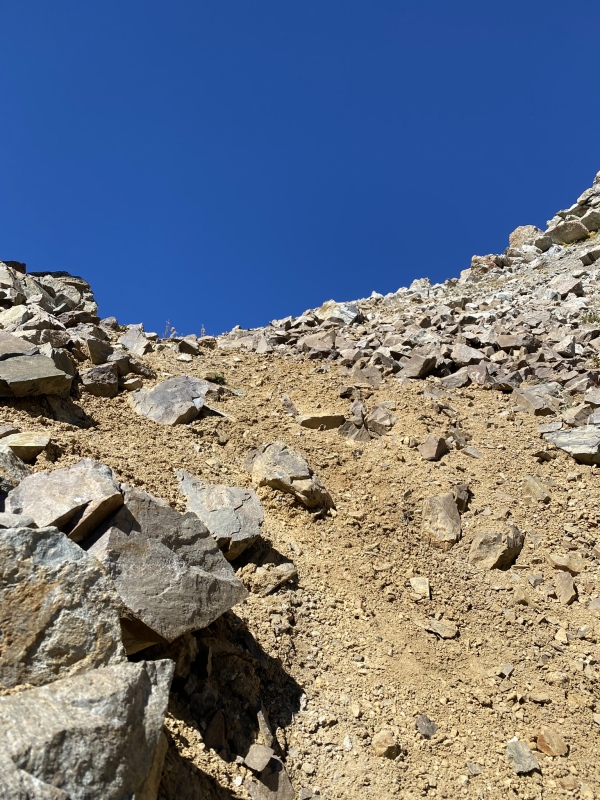

I took another long break to enjoy the awe, remove my microspikes, renourish and eventually refocus for the final summit push. As guided by skicolorado93’s trip report, my route up the final 500’ involved repeated sequences of traversing left below cliffs then turning right to one or two class 2+ moves before ascending talus slopes. One last effort brought me up to the nearly flat summit ridge at 1:30pm for another dose of elation and relief combined with awe inspring views in all directions. 


Every direction showed interesting shapes, colors and textures. I was especially fascinated by the golden aspen blankets and wrinkly rock glaciers both east and west of the summit. Unexplainably beautiful scenery, a spiritual connection to the mountains and thankfulness for a safe summit combined with shortness of breath and leftover adrenaline to make an intoxicating rocky mountain high. I spent 40 minutes on the summit soaking in the awe, taking photos, catching my breath, and calming my mind for the descent. I also called my wife to tell her that I was feeling great but would be late for dinner. I reminded her not to worry when she looked at the satellite tracker path which would be bouncing around in the cliff-confined area between the top of the gully and the lake. 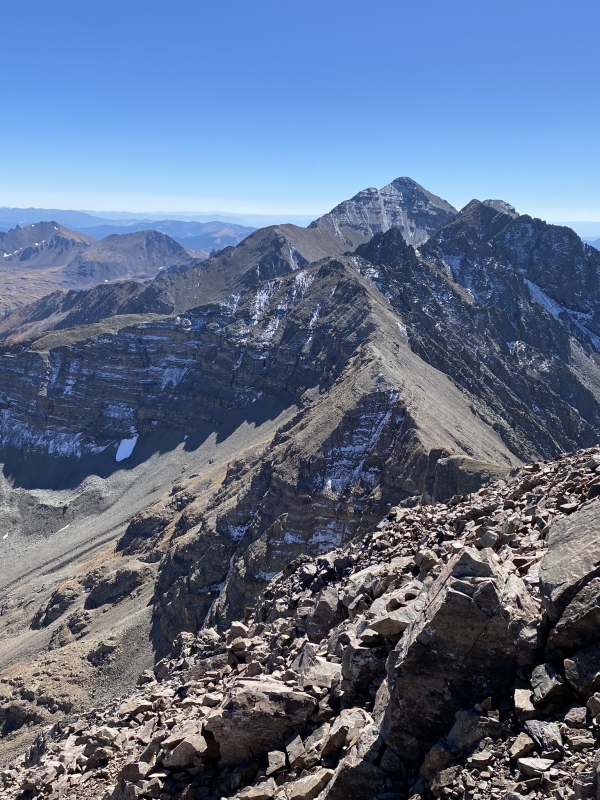
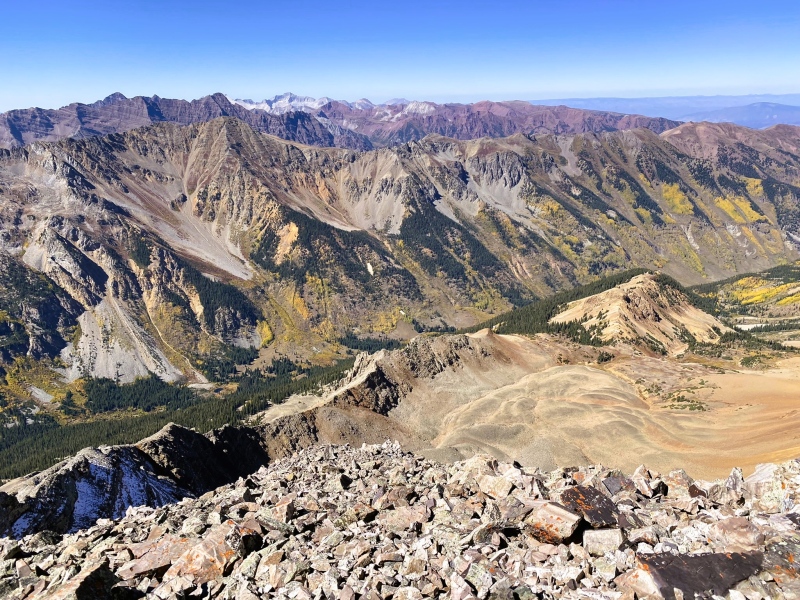
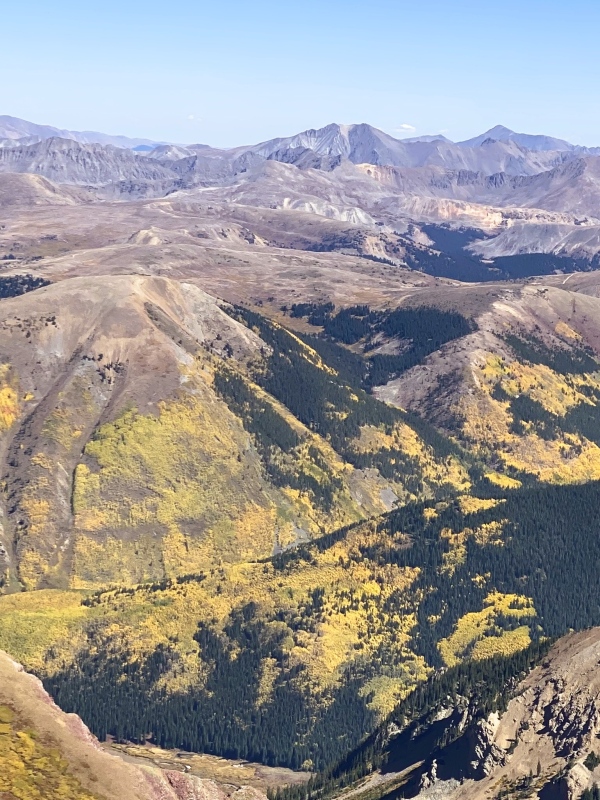
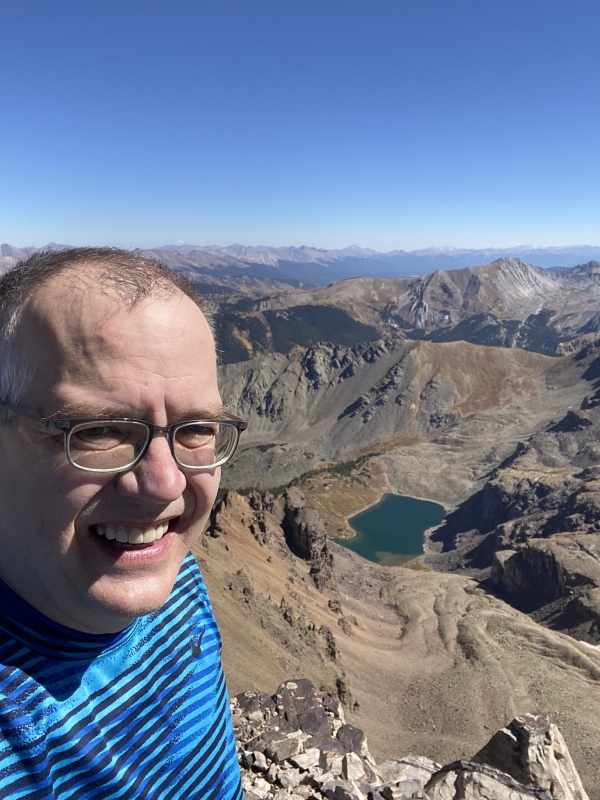
From above, the route was easy to see while retracing my steps from the summit back to the col. For potential protective padding, I put on my winter tights and tied sweater sleeves around my waist before tucking the rest of the sweater into the backside of my pants. After putting my spikes back on, I took a deep breath and started down the now-shaded gully. I tried to keep my attention on footholds and handholds and ignore the gorgeous views of the lake, aspen and distant Sawatch Range. Facing outwards, my preferred descending techniques were: both feet pointed down with the pole on one side and the other glove on a rock banister; both feet sideways with the pole on the downhill side and a glove on the uphill side; and class 3 rock lowering. Occasionally, I mixed in the crab walk and butt scootch techniques. Adrenaline was flowing again, but not nearly as much as during the ascent. I did not hear any natural rockfall while I was in the gully. I didn't knock down any rocks more than ten feet, but I still would not want to be in this gully if anyone was above or below me. 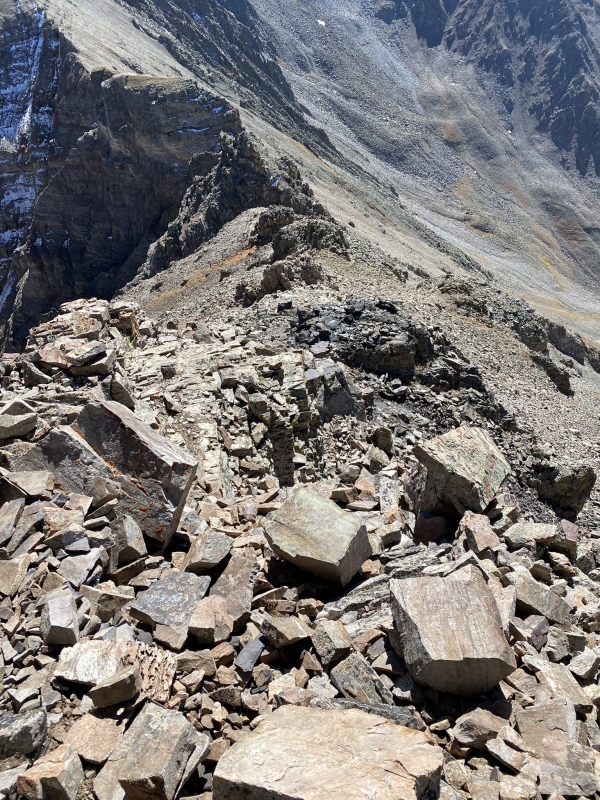
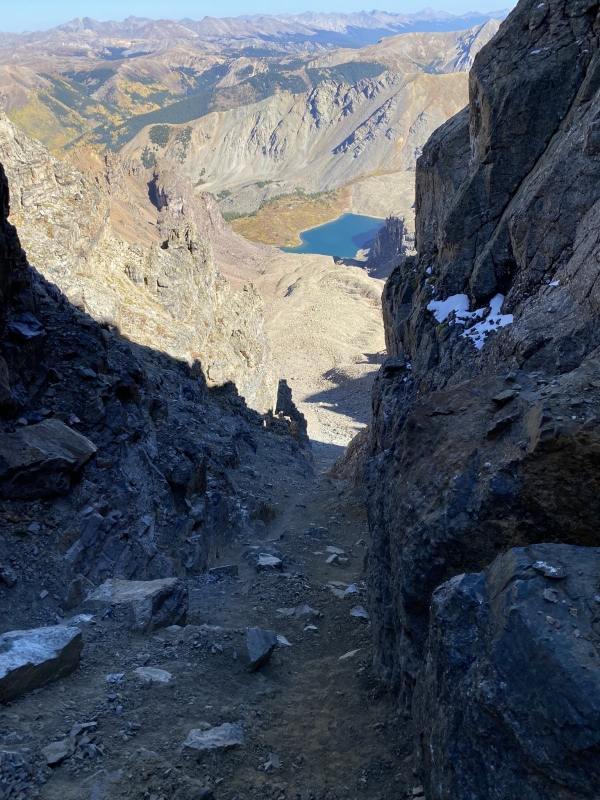
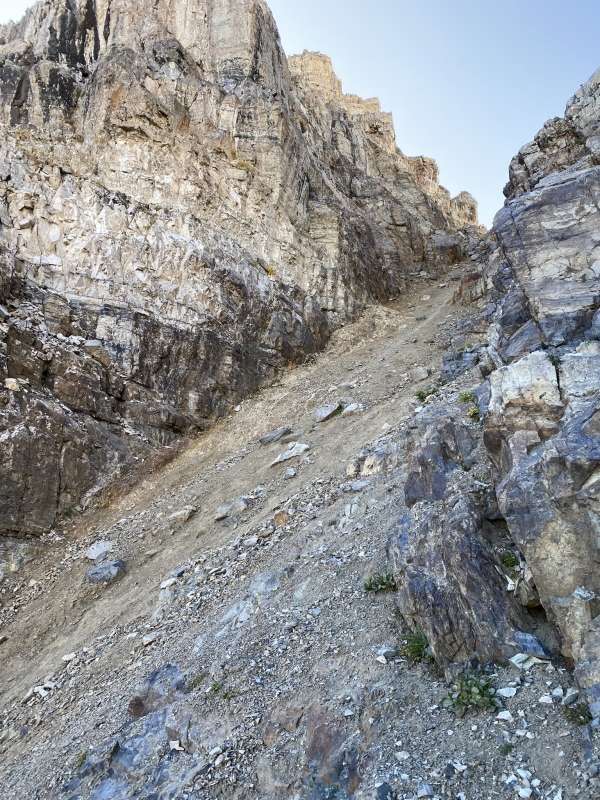
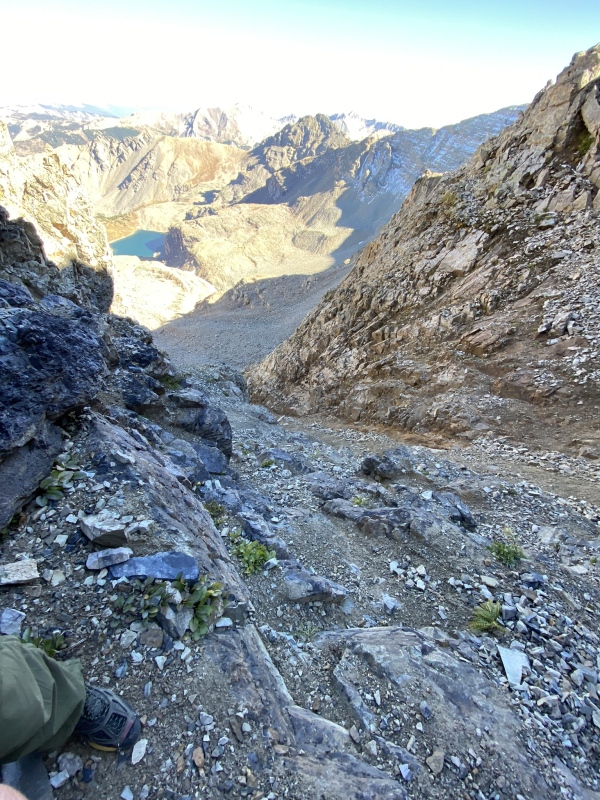
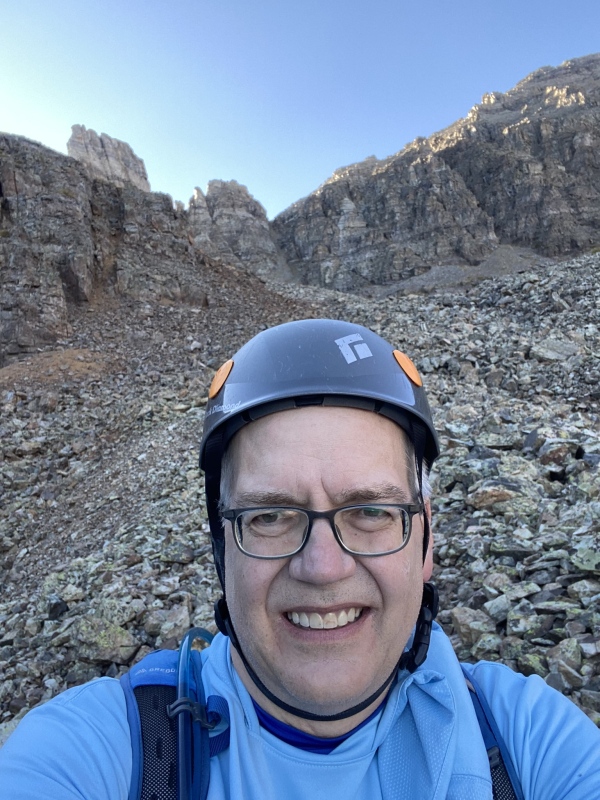
After getting out of the line of fire of the gully, I was relieved be down safely. I took off the unused padding, had a final snack and started racing the shadows down the mountain. My only stops were for filtering water, satellite texting my wife (“Sorry I’ll be too late for dinner; can you bring CP Burger back to the condo please”), taking a few photos and putting on my headlamp. As sundown turned to moonrise, the beautiful scenery, peaceful solitude and feeling of accomplishment kept my mood elevated while I descended. 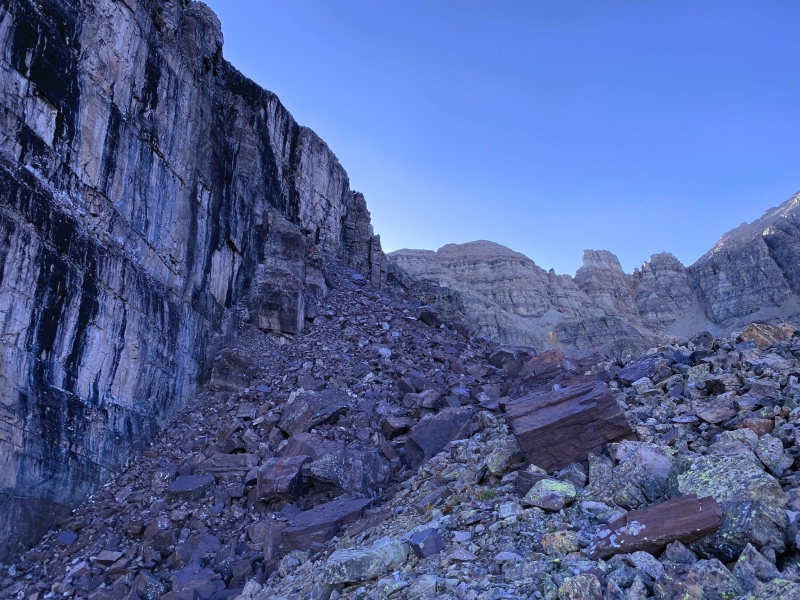
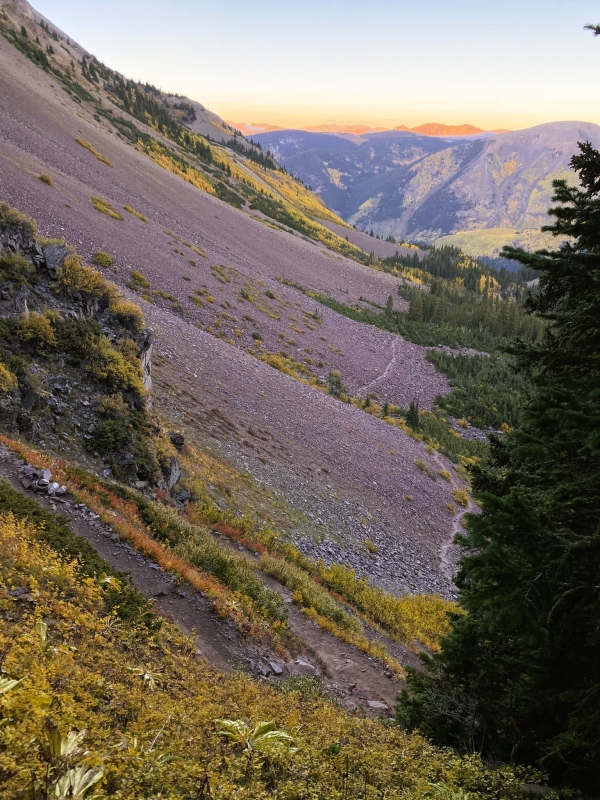

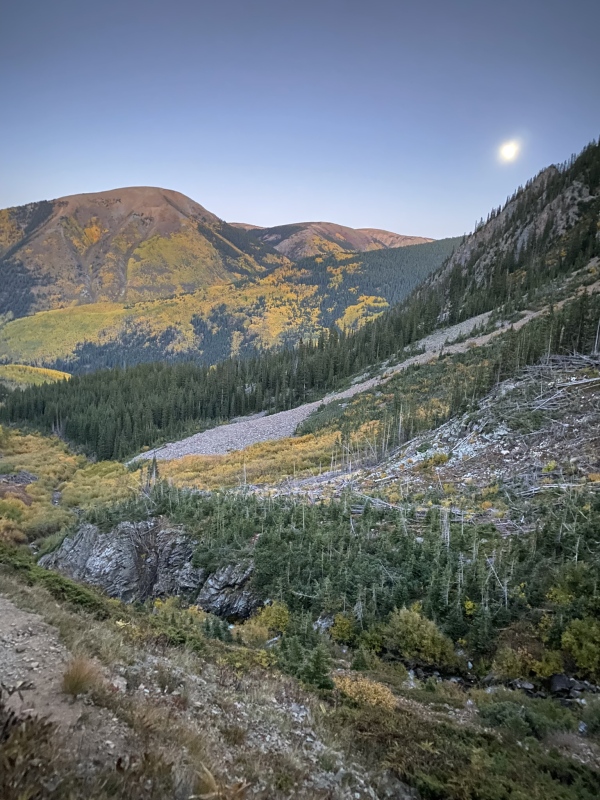
The autumn awe continued the next day with blue skies and vibrant fall colors. My wife and I enjoyed short walks and 14er views at Maroon Lake and Capitol Creek before relaxing on the patio at Woody Creek Tavern. 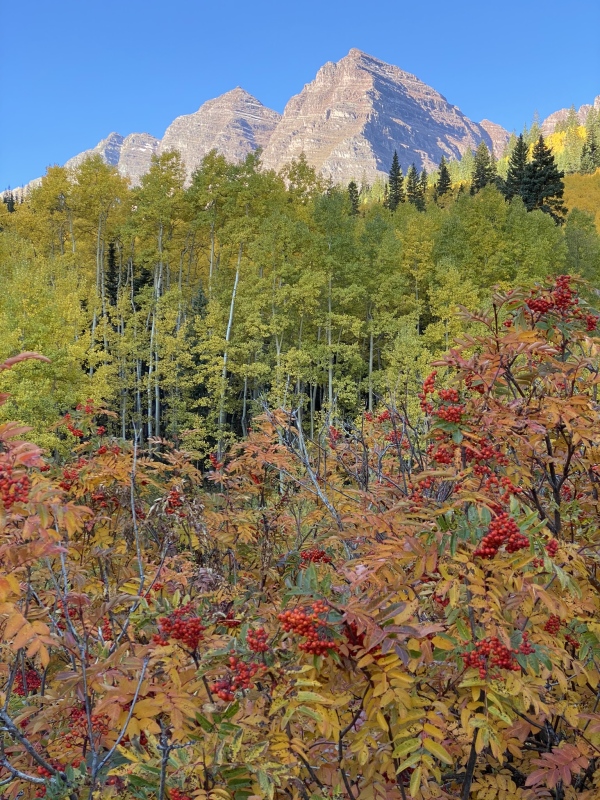

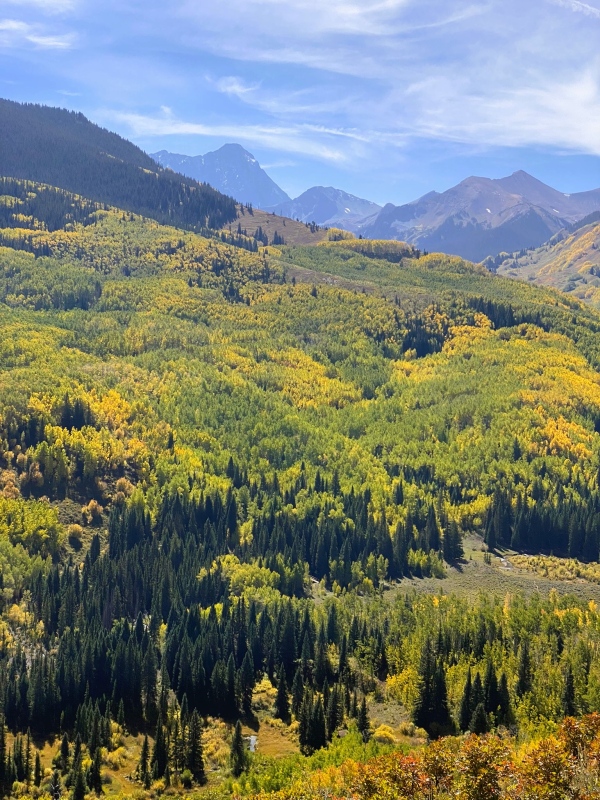
Preparation For me, the main preparations consisted of understanding the three main challenges of the route and monitoring the weather forecast. I found skicolorado93’s trip report very helpful for the first challenge—transitioning from the Electric Pass trail through the willows to find the miner’s trail. For the second challenge of climbing the dirt to the south ridge, mattpayne11’s blog post, besides featuring gorgeous photography, included rare photos showing the south gully in full dirt conditions—seeing these photos (and ignoring his warnings) convinced me that I had a chance for an autumn ascent. As previously mentioned, climbing up to Casco Peak’s Fiascol saddle from the west had me feeling confident in using microspikes, gloves and poles to ascend and descend a 45 degree slope of mixed rock and dirt. I also found a few condition reports showing Cathedral’s gully in mostly dirt conditions with some snow at the top—the snow and mud looked intimidating, but the dirt looked manageable. The third challenge of climbing the final 500’ up the south ridge is well described by WildWanderer and skicolorado93. 
Helpful trip reports:
Condition reports with photos of mainly dirt but partly snow gully conditions:
Thoughts on Snow vs Dirt for Cathedral Peak During my pre-hike research, I read nearly every Cathedral Peak trip report and conditions report on 14ers.com. I could only find a few reports from August and September. Many who climbed in dirt season finished their reports with some variation of “I would have rather climbed during snow season”. The biggest concerns seemed to come from folks who climbed partially on dirt but still had to climb up mud and then over or around slushy snow at the top of the gully; some mentioned using crampons for the mud. This year, snow stayed in the gully until at least mid-August (see andrew85 conditions report photos). By late September, the snow and mud were both gone. According to the reports, most snow-climbers are much faster than me, taking 7 to 10 hours round trip with start times mostly between 3am and 5am and summit times between 7:30am and 9:30am for safe snow conditions. My normal time estimate for class 1 or 2 is 60 minutes per 1000 feet of vertical (up or down) plus 20 minutes per mile of horizontal. For class 2+ or 3, I expect closer to 500 feet per hour. With the route being 4.5 miles, 3000 feet of class 1 and 2 and 1000 feet of class 3 and 2+, my time estimate was 6.5 hours each way, before allowing for any summit time. For a snow hike, I would likely need a 1:00am start time and would risk being a road block to other climbers in the gully. Most importantly, I would expect at least 4.5 hours from the base of the gully to the summit and back, which seems too long to count on stable snow. Overall, a September dirt climb made great sense for me due to:
But I can fully understand why a snow climb makes more sense and is more enjoyable for people with better snow travel skills, higher avalanche awareness and faster speed. I was very happy with the early fall dirt conditions during my outing, but I can’t say how narrow the window will be in any given year between when the dirt dries out and when autumn snow starts to fill the gully. 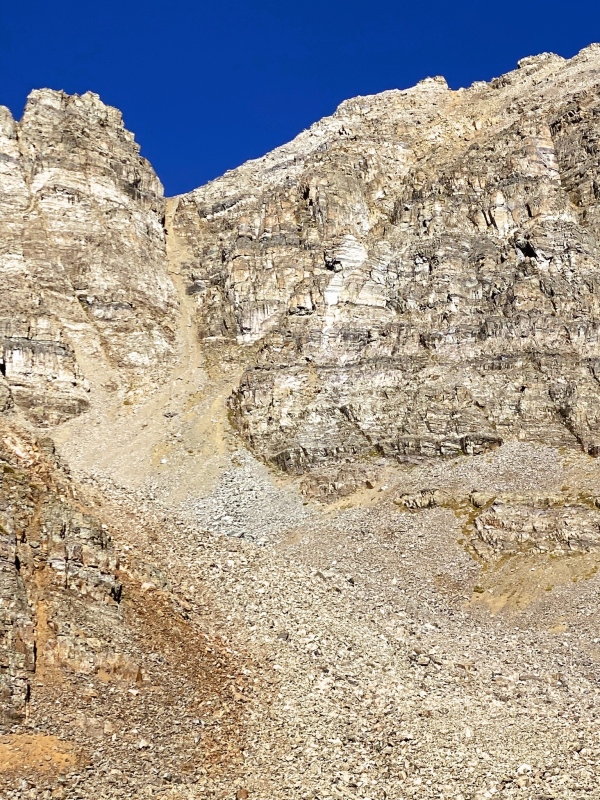
In my post-hike research, I was curious to know when most people ascend Cathedral. First, I went to 14ers.com which reports 468 member ascents; dates are publicly viewable for 32 trip reports and 69 condition reports. I counted climbs in half-month intervals and classified them based on my best interpretation of snow conditions, primarily focused on the 500 foot gully that accesses the south ridge:
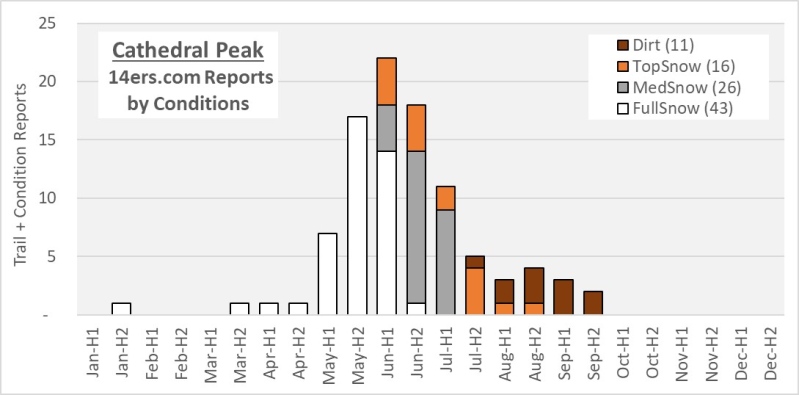
Unsurprisingly, this information lines up with Roach’s general advice of June solid snow, July top of gully snow filled, August snow remnant and September hard dirt, but be aware that some years may be several weeks ahead or behind the general advice. The timing of reports on 14ers.com may be an incomplete sample—I think people are more likely to make reports during snow transition seasons. So, I also pulled dates from peakbagger.com and listsofjohn.com which show a more distinct late summer climbing season compared to the 14ers.com trip and conditions reports. 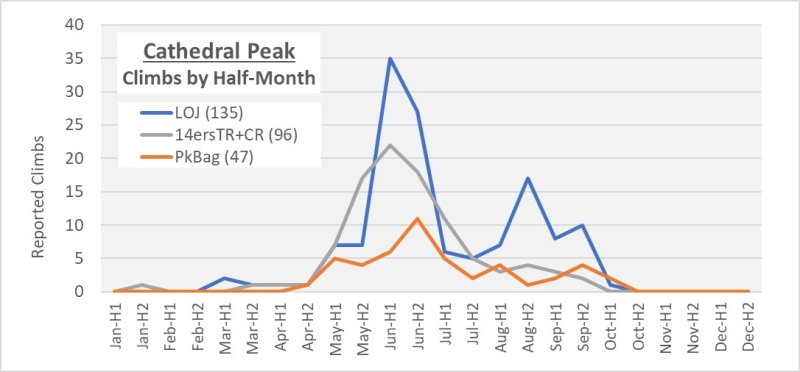
Thoughts about Awe During and after my time at Cathedral, I was wondering why I enjoyed the day so much? Feeling small while surrounded by unfamiliar and unexplainable beauty was part of the equation. A spiritual connection to the mountain factored into the formula. By some measures, the anticipatory fear of the dirt gully and the heavy exertion of a 14-hour day should have been miserable subtractions. And yet, both components were morphed by a feeling of achievement to add to my enjoyment. I can’t explain the awe equation of any particular outing, but I always hope to experience it again. After the climb, I’ve stumbled across some Outside articles discussing awe and its connection to the outdoors. Below are a few definitions and quotes that have helped me partially understand why my high mountain challenges fill me with wonder, spirituality and happiness.
By definition, awe isn’t fully understandable, but that won’t stop me from looking for more. Shortly after the Cathedral journey, my next awe-seeking road trip took me to Indio, CA to witness rock legends in concert; to Page, AZ to marvel at the mysterious rocks of Antelope Canyon; to Chaco Canyon, NM to ponder the ruins of ancient civilizations; and to Farmington, NM to admire an annular solar eclipse. I’ve already made April 8, 2024 reservations in Little Rock, AR to experience a total solar eclipse. Next summer, I’ll be on the trail again, seeking awe in the high mountain sanctuaries of Colorado—but not until the snow melts. 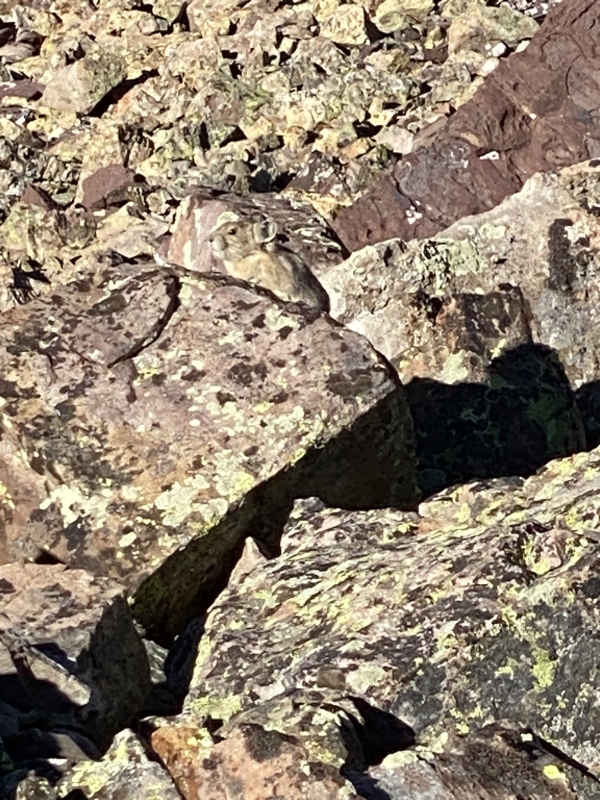
|
| Comments or Questions | ||||||||||||||||||
|---|---|---|---|---|---|---|---|---|---|---|---|---|---|---|---|---|---|---|
|
Caution: The information contained in this report may not be accurate and should not be the only resource used in preparation for your climb. Failure to have the necessary experience, physical conditioning, supplies or equipment can result in injury or death. 14ers.com and the author(s) of this report provide no warranties, either express or implied, that the information provided is accurate or reliable. By using the information provided, you agree to indemnify and hold harmless 14ers.com and the report author(s) with respect to any claims and demands against them, including any attorney fees and expenses. Please read the 14ers.com Safety and Disclaimer pages for more information.
Please respect private property: 14ers.com supports the rights of private landowners to determine how and by whom their land will be used. In Colorado, it is your responsibility to determine if land is private and to obtain the appropriate permission before entering the property.
